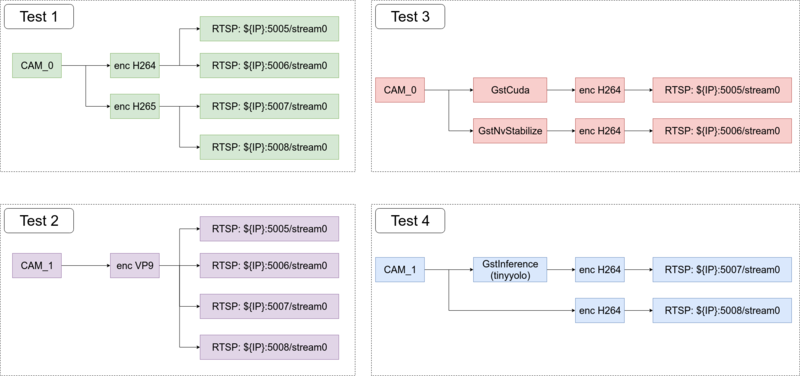RidgeRun Toolbox Demo
Contents
Introduction
RidgeRun has developed several GStreamer plugins, this wiki shows some examples with four test scripts that can be used as a quick demo of their capabilities.
Dependencies
This wiki assumes all the following plugins and dependencies are successfully installed:
Summary
The following image shows the data path for some of the most common use cases that will be presented in this demo:
Visualization
To receive incoming buffers from each of the pipelines you can use programs like vlc or totem. For example to view the output buffers from H264/H265 pipelines you can use:
vlc rtsp://${HOST_IP}:6005/stream0
To view the output buffers from VP9/VP8 pipelines you can use:
totem rtsp://${HOST_IP}:6005/stream0
Considerations
Each script includes some definitions needed to run, you can change them to match your needs. For example camera settings:
CAM0=0
CAM0_WIDTH=1280
CAM0_HEIGHT=720
CAM0_FRAMERATE=120
Please pay special attention to definitions at:
- test3.sh:
Update the PATH_TO_CUDA_FILTER definition to match the path where you downloaded the Gst-cuda eval.
PATH_TO_CUDA_FILTER=/home/user/gst-cuda/tests/examples/cudafilter_algorithms/gray-scale-filter/gray-scale-filter.so
- test4.sh:
Update the MODEL_LOCATION and LABELS definitions needed for the Gst-Inference plugin.
labels.txt: attached to this wiki
graph_tinyyolov2_tensorflow.pb: you can get the tensorflow model for free at the following link.
MODEL_LOCATION='/home/user/graph_tinyyolov2_tensorflow.pb'
LABELS='/home/user/labels.txt'
Tests
Before running each test please ensure gstreamer daemon (gstd) is up and running:
gstd -k
gstd
test1.sh
CAM0=0
CAM0_SRC=cam${CAM0}_src
CAM0_PIPE=${CAM0_SRC}_pipe
CAM0_WIDTH=1280
CAM0_HEIGHT=720
CAM0_FRAMERATE=120
########## GREEN PIPELINE ##########################
#1. Create camera input
echo -e "===> Create the h264 ${CAM0_PIPE}\n"
gstd-client pipeline_create ${CAM0_PIPE} nvarguscamerasrc sensor-id=${CAM0} ! "video/x-raw(memory:NVMM), width=(int)${CAM0_WIDTH}, \\
height=(int)${CAM0_HEIGHT}, format=(string)NV12, framerate=(fraction)${CAM0_FRAMERATE}/1" ! nvvidconv \
! interpipesink name=${CAM0_SRC} sync=false async=false
#2.1 Create h264 encoding
gstd-client pipeline_create x264_pipe interpipesrc name=x264_src listen-to=${CAM0_SRC} \
! omxh264enc ! "video/x-h264,stream-format=(string)byte-stream" \
! h264parse ! "video/x-h264,mapping=/stream0" ! \
interpipesink name=x264_sink sync=false async=false
#2.2 Create h265 encoding
gstd-client pipeline_create x265_pipe interpipesrc name=x265_src listen-to=${CAM0_SRC} \
! omxh265enc ! "video/x-h265,stream-format=(string)byte-stream" \
! h265parse ! "video/x-h265,mapping=/stream0" ! \
interpipesink name=x265_sink sync=false async=false
#3.1 Create rtspsink 1
echo -e "===> Create the output rtsp sinks \n"
gstd-client pipeline_create stream0_pipe interpipesrc name=rtsp0 listen-to=x264_sink \
! rtspsink service=6005
#3.2 Create rtspsink 2
gstd-client pipeline_create stream1_pipe interpipesrc name=rtsp1 listen-to=x264_sink \
! rtspsink service=6006
#3.3 Create rtspsink 2
echo -e "===> Create the output rtsp sinks \n"
gstd-client pipeline_create stream2_pipe interpipesrc name=rtsp0 listen-to=x265_sink \
! rtspsink service=6007
#3.4 Create rtspsink 4
gstd-client pipeline_create stream3_pipe interpipesrc name=rtsp1 listen-to=x265_sink \
! rtspsink service=6008
gstd-client pipeline_play ${CAM0_PIPE}
gstd-client pipeline_play x264_pipe
gstd-client pipeline_play x265_pipe
gstd-client pipeline_play stream0_pipe
gstd-client pipeline_play stream1_pipe
gstd-client pipeline_play stream2_pipe
gstd-client pipeline_play stream3_pipe
####################################################
test2.sh
CAM1=0
CAM1_SRC=cam${CAM1}_src
CAM1_PIPE=${CAM1_SRC}_pipe
CAM1_WIDTH=1280
CAM1_HEIGHT=720
CAM1_FRAMERATE=120
########## PURPLE PIPELINE ##########################
#1. Create camera input
echo -e "===> Create the ${CAM1_PIPE}\n"
gstd-client pipeline_create ${CAM1_PIPE} nvarguscamerasrc sensor-id=${CAM1} ! "video/x-raw(memory:NVMM), width=(int)${CAM1_WIDTH}, \\
height=(int)${CAM1_HEIGHT}, format=(string)NV12, framerate=(fraction)${CAM1_FRAMERATE}/1" \
! interpipesink name=${CAM1_SRC} sync=false async=false
#2.1 Create h264 encoding
gstd-client pipeline_create vp9_pipe interpipesrc name=vp9_src listen-to=${CAM1_SRC} \
! omxvp9enc ! "video/x-vp9, mapping=/stream0" ! queue \
! interpipesink name=vp9_sink sync=false async=false
#3.1 Create rtspsink 1
echo -e "===> Create the output rtsp sinks \n"
gstd-client pipeline_create stream0_pipe interpipesrc name=rtsp0 listen-to=vp9_sink \
! rtspsink service=6005
gstd-client pipeline_create stream1_pipe interpipesrc name=rtsp1 listen-to=vp9_sink \
! rtspsink service=6006
gstd-client pipeline_create stream2_pipe interpipesrc name=rtsp2 listen-to=vp9_sink \
! rtspsink service=6007
gstd-client pipeline_create stream3_pipe interpipesrc name=rtsp3 listen-to=vp9_sink \
! rtspsink service=6008
gstd-client pipeline_play ${CAM1_PIPE}
gstd-client pipeline_play vp9_pipe
gstd-client pipeline_play stream0_pipe
gstd-client pipeline_play stream1_pipe
gstd-client pipeline_play stream2_pipe
gstd-client pipeline_play stream3_pipe
####################################################
test3.sh
CAM0=0
CAM0_SRC=cam${CAM0}_src
CAM0_PIPE=${CAM0_SRC}_pipe
CAM0_WIDTH=1280
CAM0_HEIGHT=720
CAM0_FRAMERATE=120
PATH_TO_CUDA_FILTER=/home/user/gst-cuda/tests/examples/cudafilter_algorithms/gray-scale-filter/gray-scale-filter.so
########## RED PIPELINE ##########################
#1. Create camera input
echo -e "===> Create the ${CAM0_PIPE} pipeline\n"
gstd-client pipeline_create ${CAM0_PIPE} nvarguscamerasrc sensor-id=${CAM0} ! "video/x-raw(memory:NVMM), width=(int)${CAM0_WIDTH}, \\
height=(int)${CAM0_HEIGHT}, format=(string)NV12, framerate=(fraction)${CAM0_FRAMERATE}/1" \
! interpipesink name=${CAM0_SRC} sync=false async=false
#2.1 Use GstNvStabilize element
gstd-client pipeline_create stabilize_pipe interpipesrc name=stabilize_src listen-to=${CAM0_SRC} \
! nvvidconv ! nvstabilize crop-margin=0.1 queue-size=5 ! nvvidconv ! 'video/x-raw(memory:NVMM)' ! nvvidconv \
! interpipesink name=stabilize_sink sync=false async=false
#2.2 Use GstCuda element
gstd-client pipeline_create cuda_pipe interpipesrc name=cuda_src listen-to=${CAM0_SRC} \
! nvvidconv ! "video/x-raw(memory:NVMM),width=1280,height=720,format=I420,framerate=120/1" ! nvvidconv \
! cudafilter in-place=true location=${PATH_TO_CUDA_FILTER} \
! interpipesink name=cuda_sink sync=false async=false
#3.1 Create h264 encoding
gstd-client pipeline_create x264_pipe interpipesrc name=x264_src listen-to=cuda_sink \
! omxh264enc ! "video/x-h264,stream-format=(string)byte-stream" \
! h264parse ! "video/x-h264,mapping=/stream0" ! \
interpipesink name=x264_sink sync=false async=false
#3.2 Create h264 encoding
gstd-client pipeline_create x264_pipe2 interpipesrc name=x264_src2 listen-to=stabilize_sink \
! omxh264enc ! "video/x-h264,stream-format=(string)byte-stream" \
! h264parse ! "video/x-h264,mapping=/stream0" ! \
interpipesink name=x264_sink2 sync=false async=false
#4.1 Create rtspsink 1
echo -e "===> Create the output rtsp sinks \n"
gstd-client pipeline_create stream0_pipe interpipesrc name=rtsp0 listen-to=x264_sink \
! rtspsink service=6005
#4.2 Create rtspsink 2
gstd-client pipeline_create stream1_pipe interpipesrc name=rtsp1 listen-to=x264_sink2 \
! rtspsink service=6006
gstd-client pipeline_play ${CAM0_PIPE}
gstd-client pipeline_play stabilize_pipe
gstd-client pipeline_play cuda_pipe
gstd-client pipeline_play x264_pipe
gstd-client pipeline_play x264_pipe2
gstd-client pipeline_play stream0_pipe
gstd-client pipeline_play stream1_pipe
###################################################
test4.sh
CAM1='/dev/video1'
CAM1_WIDTH=1280
CAM1_HEIGHT=720
MODEL_LOCATION='/home/user/graph_tinyyolov2_tensorflow.pb'
INPUT_LAYER='input/Placeholder'
OUTPUT_LAYER='add_8'
LABELS='/home/user/labels.txt'
############# BLUE PIPELINE ####################
#1. Create camera input
echo -e "===> Create the ${CAM1} pipeline\n"
gstd-client pipeline_create cam1_pipe v4l2src device=$CAM1 \
! "video/x-raw, width=${CAM1_WIDTH}, height=${CAM1_HEIGHT}" \
! interpipesink name=cam1_src sync=false async=false
#2.1 Use Gst-inference plugin
gstd-client pipeline_create inference_pipe interpipesrc name=inference_src listen-to=cam1_src \
! videoconvert ! tee name=t t. ! videoscale ! queue ! net.sink_model t. ! queue \
! net.sink_bypass tinyyolov2 name=net model-location=$MODEL_LOCATION backend=tensorflow \
backend::input-layer=$INPUT_LAYER backend::output-layer=$OUTPUT_LAYER net.src_bypass \
! detectionoverlay labels="$(cat $LABELS)" font-scale=1 thickness=2 ! videoconvert \
! omxh264enc ! "video/x-h264,stream-format=(string)byte-stream" \
! h264parse ! "video/x-h264,mapping=/stream0" \
! rtspsink service=6007
#2.2 Encode h264 video
gstd-client pipeline_create cam1_empty interpipesrc name=cam_src_empty listen-to=cam1_src \
! videoconvert ! omxh264enc ! "video/x-h264,stream-format=(string)byte-stream" \
! h264parse ! "video/x-h264,mapping=/stream0" \
! rtspsink service=6008
gstd-client pipeline_play cam1_pipe
gstd-client pipeline_play cam1_empty
gstd-client pipeline_play inference_pipe
###############################################
labels.txt
The file is needed by the gst-inference demo:
labels.txt
aeroplane;bicycle;bird;boat;bottle;bus;car;cat;chair;cow;diningtable;dog;horse;motorbike;person;pottedplant;sheep;sofa;train;tvmonitor
